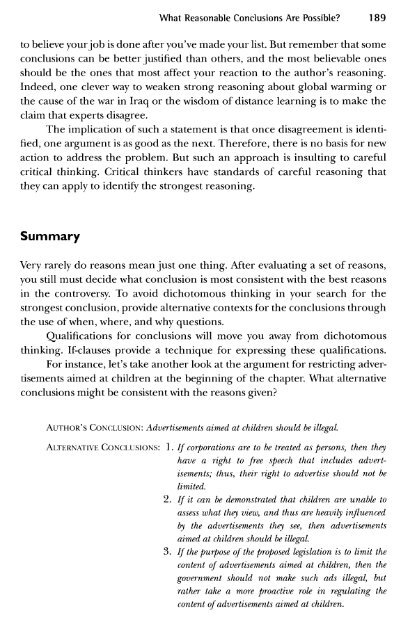Asking the Right Questions, A Guide to Critical Thinking, 8th Ed
Asking the Right Questions, A Guide to Critical Thinking, 8th Ed
Asking the Right Questions, A Guide to Critical Thinking, 8th Ed
You also want an ePaper? Increase the reach of your titles
YUMPU automatically turns print PDFs into web optimized ePapers that Google loves.
What Reasonable Conclusions Are Possible? 189<br />
<strong>to</strong> believe your job is done after you've made your list. But remember that some<br />
conclusions can be better justified than o<strong>the</strong>rs, and <strong>the</strong> most believable ones<br />
should be <strong>the</strong> ones that most affect your reaction <strong>to</strong> <strong>the</strong> author's reasoning.<br />
Indeed, one clever way <strong>to</strong> weaken strong reasoning about global warming or<br />
<strong>the</strong> cause of <strong>the</strong> war in Iraq or <strong>the</strong> wisdom of distance learning is <strong>to</strong> make <strong>the</strong><br />
claim that experts disagree.<br />
The implication of such a statement is that once disagreement is identified,<br />
one argument is as good as <strong>the</strong> next. Therefore, <strong>the</strong>re is no basis for new<br />
action <strong>to</strong> address <strong>the</strong> problem. But such an approach is insulting <strong>to</strong> careful<br />
critical thinking. <strong>Critical</strong> thinkers have standards of careful reasoning that<br />
<strong>the</strong>y can apply <strong>to</strong> identify <strong>the</strong> strongest reasoning.<br />
Summary<br />
Very rarely do reasons mean just one thing. After evaluating a set of reasons,<br />
you still must decide what conclusion is most consistent with <strong>the</strong> best reasons<br />
in <strong>the</strong> controversy. To avoid dicho<strong>to</strong>mous thinking in your search for <strong>the</strong><br />
strongest conclusion, provide alternative contexts for <strong>the</strong> conclusions through<br />
<strong>the</strong> use of when, where, and why questions.<br />
Qualifications for conclusions will move you away from dicho<strong>to</strong>mous<br />
thinking. If-clauses provide a technique for expressing <strong>the</strong>se qualifications.<br />
For instance, let's take ano<strong>the</strong>r look at <strong>the</strong> argument for restricting advertisements<br />
aimed at children at <strong>the</strong> beginning of <strong>the</strong> chapter. What alternative<br />
conclusions might be consistent with <strong>the</strong> reasons given?<br />
AUTHOR'S CONCLUSION: Advertisements aimed at children should be illegal.<br />
ALTERNATIVE CONCLUSIONS: 1. If corporations are <strong>to</strong> be treated as persons, <strong>the</strong>n <strong>the</strong>y<br />
have a right <strong>to</strong> free speech that includes advertisements;<br />
thus, <strong>the</strong>ir right <strong>to</strong> advertise should not be<br />
limited.<br />
2. If it can be demonstrated that children are unable <strong>to</strong><br />
assess what <strong>the</strong>y view, and thus are heavily influenced<br />
by <strong>the</strong> advertisements <strong>the</strong>y see, <strong>the</strong>n advertisements<br />
aimed at children should be illegal.<br />
3. If <strong>the</strong> purpose of <strong>the</strong> proposed legislation is <strong>to</strong> limit <strong>the</strong><br />
content of advertisements aimed at children, <strong>the</strong>n <strong>the</strong><br />
government should not make such ads illegal, but<br />
ra<strong>the</strong>r take a more proactive role in regulating <strong>the</strong><br />
content of advertisements aimed at children.



